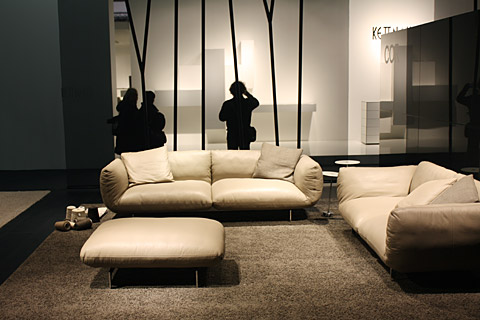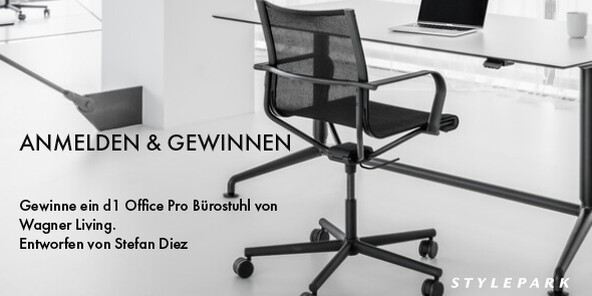"Pure Textile" is one of the two new sections at the imm Cologne 2011 and is dedicated to textiles. The organizers declare that the section provides "a perfect stage for editors of selected interior fabrics on which to place their refined collections in the right light. Integrated into the "Pure" section of the fair, and thus surrounded by absolutely superlative design by the most renowned of international furniture makers, the exquisite textiles come truly into their own interacting with furniture and accessories." Unfortunately, this only occurs to a limited extent, and not because of the textile editors or their booths. Instead, the makers at Messe Köln (Frankfurt Trade Fair) have been somewhat generous in their interpretation of the notion of context. Essentially, the interaction of furniture, wallpapers, curtains and carpets is limited to a single fact: they are all located in the same hall and anyone browsing around has to link up the dots for himself. Anyone who had expected that here for once a broader interdisciplinary scope would come to bear and the individual products not be presented in isolation (possibly in rooms specially create for this purpose), saw their hopes dashed. Only the space between the textile companies was furnished: with hard benches and a few fabric stools, and you needed to be very favorably inclined to it all to consider the quality fitting in light of what the manufacturers had on show. The simple fact is that an apartment is a single entity and does not disintegrate into countless individual objects. To assuming it does fits only the logic of a trade fair, which divides the world up into individual booths. Precisely because the new section is clearly circumscribed, there would have been a real opportunity to try out something new here. For example, to allow one manufacturer to furnish an entire room with the furniture partner of its choice, now that would have been something different at least.
This side of the Orontes
Yet it is nevertheless true that anyone who as a child rode out into the prairie on the wings of their imagination has at some point to return. Above all, a man of the world ever more frequently lands not on hard smooth ground, but on a carpet. For all the blurb on trends and the like, we should have known and certainly could have guessed that in many apartments in recent years parquet has been laid, laminate floors put in place, or broad and beautiful wooden floor boards deployed. As a result there is plenty of free space that cannot in the long run remain but will likewise also not necessarily be filled with traditional Persian carpets. Because most of this hand-knotted carpets that conquered apartments in the Occident from the mid-19th century onwards, rarely harmonize now with more recent designer furniture. Moreover, where once people imagined hanging gardens and fairytales from the Arabian Nights, today doubts arise, as the one or other starts wondering, rightly or wrongly, whether the carpets were not produced exploitatively by nimble children's fingers. So what had to happen happened: New carpets were needed. And thus almost every manufacturer who knows his textiles (and definitely not just them) expanded the product line to include new, usually well designed carpets made of refined materials.
It is at present hard to gauge what the return of the carpet in concert with the reanimation of wallpaper and refined curtain materials will actually mean. Are we seeing the beginnings of a turn away from the Modernist ‘white cell'? Or has the fear of the ostentatious backdrop given way, after all, to a more opulent, Baroque/Catholic image? Whatever triggered the change, one thing is certain: Carpets in the widest range of different colors and patterns have long since ceased to be added frills, but contribute substantially to the design of a room - be it commercial premises or a private villa or apartment.
Deconstructed tradition
In recent years, carpet designer Jan Kath has certainly outstripped his peers as regards deconstructing the historical troves of patterns and colors. What he does is to simulate and remix, to bring together the far removed and the close and hand, and yet keep them separate. What this attention to tradition and its phantasms has yielded can (if we perhaps exaggerate slightly) be termed a philosophical discourse that visualizes contemporary society's restlessness in dealing with interiors. Thus, Kath has developed not only a completely unique carpet philosophy and along with it a new typology, but is also a past master at playing through the full range of reminiscences, fragments, the well-trodden paths and the frayed edges. In the process, he repeatedly succeeds in creating surprising "images" of an interior culture that draws on global patterns by reactivating and transforming them.
At the end of the day, you have a carpet in your living room that on the one hand looks like a well-worn Oriental carpet, and yet again does not. Rather, the carpet oscillates between its own historicity and the overcoming of those historical roots, and is, as it were, imbued with the process that outlasted the carpet and yet led to its downfall.
In Cologne, Jan Kath has various collections on display. Here, tradition is simulated and processed quite openly by placing fragments of seemingly traditional patterns on a monochrome ground. There, Kath places a red, green or blue ornamental texture on a patchy ground, as if it were a fleeting memory. Where these carpets hang on the wall, they tend to resemble works by the Abstract Expressionists or art informel rather than carpets, something that does not exactly make it easy to decide to lay them on the floor. In other words, there are many variants to Kath's art of playing with background and figure, of erasing and showing. Another project shows only too clearly that patterns are never just patterns and are definitely not neutral. "BP" is the name of a coming collection that was unfortunately not yet on show in Cologne and for which Kath has used shots of the disastrous oil spill in the Gulf of Mexico. Bringing politics out onto the carpet. And anyone owning a good old carpet that he wants to revitalize can simply give it a completely new look by using the "Pimp My Rug" program. The carpet is simply dyed using a completely new process and then given a new look flair with neon colors.
Tradition transforms
There are surely also less radical forms of time travel. Manufacturer Sahco Hesslein opts for one such path. Here, again, tradition plays a part, but is not ruptured and instead consciously rejuvenated. Textile products are offered that boast perfect craftsmanship and across different lines such as "Creative Interiors" or "New Standard" - bringing that touch of exclusiveness to any room. Sahco not only makes new woven carpets available, but under the brand name "Sahco Fine Rugs" is now marketing a range of carpet designed to match fabrics and wallpaper, which only goes to show that something is changing in the field of exclusive interior design.
Textile twist
At the tender age of 125, Création Baumann still forgoes carpets. Instead of looking downwards, a jubilee spiral has been filled, primarily with marvelous fabrics from the "Natura" line; with all the different variants they could well change the minds of even the most dyed-in-the-wool opponents of curtains. Moreover, the company is also offering a children's version of the flexible, self-adhering and multi-use "Gecko" decoration system for indoor glass surfaces. Kinnasand, by contrast, has launched a carpet collection called "Vintage", that is replete in playful historical reminiscences. Anyone who finds Jan Kath's carpets too radical or dominant will find something no doubt among the "Vintage classic" patterns, classical and in pastel hues and yet surprisingly fresh and summery. "Vintage plain" offers 15 monochrome versions, while "Vintage contemporary" provides a series of contemporary kelims, including ones with staggered pastel stripes.
Anyone who still wants more should move on to the Design Post and there to Kvadrat and view the cushions and curtain fabrics with prints designed by Cristian Zuzunaga and "Waterborn", a new type of microfiber textile (a sustainable product!), and at Fanny Aronsen there are three luxury fabrics combined with the evidently unavoidable Swarowski crystals, and, in the form of "Hermod" a velour made of cotton and mohair, whereby a background color seems to shimmer through the weave. Ingeniously marvelous! Even if the whole thing with fabrics and carpets is sensitive. It is all very well to see pictures of them, but you need to be able to hold them and feel them. Meaning: Go to the fair.
 Création Baumann
Création Baumann
 At Pure Textiles
At Pure Textiles

 Avenue by Woodnotes
Avenue by Woodnotes
 Stand by de Sede
Stand by de Sede
 28 Custom by Bocci
28 Custom by Bocci
 At Piure
At Piure
 Jalis Sofa by Jehs+Laub for Cor
Jalis Sofa by Jehs+Laub for Cor
 special exhibition at Design Post
special exhibition at Design Post
 Emotional Austerity
Emotional Austerity
 Plytube Stool by Seongyong Lee, D3 Design Talents
Plytube Stool by Seongyong Lee, D3 Design Talents
 "DIALOG First Edition" by Vorwerk Teppiche
"DIALOG First Edition" by Vorwerk Teppiche
 Jab Anstoetz, all photos: Dimitrios Tsatsas
Jab Anstoetz, all photos: Dimitrios Tsatsas
 Nya Nordiska
Nya Nordiska
 Sahco Hesslein
Sahco Hesslein
 Création Baumann
Création Baumann
 At Jan Kath
At Jan Kath
 At Draenert
At Draenert
 14 Sconce by Bocci
14 Sconce by Bocci
 At Cor
At Cor
 Sideboards by Eric Degenhardt für Böwer
Sideboards by Eric Degenhardt für Böwer
 Emotional Austerity curated by Patricia Urquiola
Emotional Austerity curated by Patricia Urquiola
 Accordion Cabinet by Eliza Strozyk, Sebastian Neeb, D3 Design Talents
Accordion Cabinet by Eliza Strozyk, Sebastian Neeb, D3 Design Talents
 Vorwerk Teppiche
Vorwerk Teppiche

